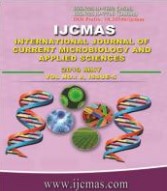


 National Academy of Agricultural Sciences (NAAS)
National Academy of Agricultural Sciences (NAAS)

|
PRINT ISSN : 2319-7692
Online ISSN : 2319-7706 Issues : 12 per year Publisher : Excellent Publishers Email : editorijcmas@gmail.com / submit@ijcmas.com Editor-in-chief: Dr.M.Prakash Index Copernicus ICV 2018: 95.39 NAAS RATING 2020: 5.38 |
Drought is a complex natural phenomenon and its impact on agriculture is enormous. The vegetation status was verified using MODIS satellite images through the Normalized Differential Vegetation Index (NDVI) for different agro-climatic zones (ACZ) over Tamil Nadu during the north-east monsoon season of 2015 (as extremely wet year), 2016 (as drought year) and 2017 (as normal year) for our analysis and it showed that satellite data was very effective for assessing the agricultural drought. From this analysis it was found that there is no much variation in the area obtained by the NDVI for that year of 2015 where 34.9 % stressed area in the north eastern zones. It is believed that the increased status of NDVI over these seasons is due to the extreme rain in this year. The stressed area was more prominent over the north eastern zone (48.3 %) in the year of 2016 and also second highest stressed area among the seasons because of the drought year. While in the year 2017 it was found that 49.9 per cent area was stressed in western zone and highest stressed area among the different zones. Therefore, the vegetation status was high during the year of 2015 compared to the remaining years of season.
 |
 |
 |
 |
 |